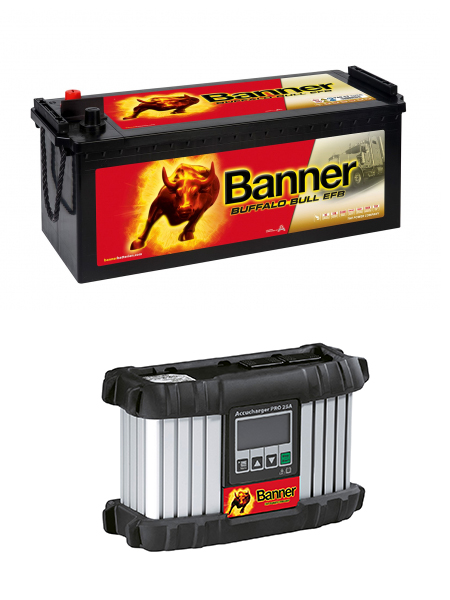Battery tips for commercial vehicles
For constant full power and a long service life
Spring is the ideal moment for a battery check in combination with external equalisation charging. Therefore, the starter specialist Banner is pleased to provide the following key tips for extended battery life.
Leonding, 2 March 2020. Andreas Bawart, Banner’s Commercial CEO, hits the nail on the head when he states that, “Frequent short trips during distribution transports, irregular driving profiles in combination with stop-and-go traffic, daily cold starts in generally icy winter temperatures and additional electrical consumers such as seat and stationary heating in long-haul trucks all serve to gradually reduce battery energy levels.” This means that as compared to their counterparts in cars, truck batteries are discharged more frequently and therefore the Banner CEO recommends that at the latest, batteries should be recharged externally when tyres are changed in spring. Moreover, against this background, it is important that the batteries are recharged externally at least twice annually. Should this not be the case, the open-circuit voltage in a 24V vehicle electrical system, which involves two 12V batteries connected in series, may fall from 25.44V to 24.6V or even lower, with all the related negative consequences.

Longer maximum voltage, no start problems or unplanned failures
As far as prolonged battery life is concerned, the following points must always be constantly borne in mind:
- First. Before charging, check the electrolyte level. If necessary, the battery should be topped up with desalinated or distilled water to the acid level mark or 15 mm above the upper edge of the plates. During charging, the battery screws may not remain open and it is best when they are screwed back in. Warning! AGM batteries may not be opened. Acid density measurement and refilling with distilled water are neither necessary nor possible.
- Second. Inactive batteries are subject to discharge. Lead sulphate collects on the lead plates and hinders the current flow with the result that battery capacity and cold start performance both decline. Devices such as the Banner Accucharger 10A/24V and the Accucharger PRO 25A keep the battery active and prevent sulphation.
- Third. The charge level of the battery must be constantly monitored. The display provides up-to-date information regarding current power consumption and alarms the driver if for example the charge status is too low. This is important as a long-haul truck is generally not simply a means of transport, but instead often the workplace and home of the driver for five days of the week.
- Fourth. A drop in temperature from +20 to 18°C for example, roughly halves battery capacity in Ah. Therefore, not only should the battery charge status be subject to surveillance, but also the additional consumers must be used in moderation, especially when the vehicle is not in use.
- Fifth. Electrical consumers should be shut down as soon as they are no longer required. As a result, when the engine is switched off, battery current will only be employed for a refrigerator, tablet, computer, or sound system.
- Sixth. A suitable vehicle mode should always be employed once the engine is turned off and the parking mode actuated. This applies if the cab functions are not in use, but should they be needed a switch to the accommodation mode is necessary for as long as the cab functions are required. Afterwards, the parking mode can be reactivated. Additional cab functions are available via the accessory mode, but care should be taken that this is also only utilised for a limited period, in order that battery power is not fully exhausted.
Play it safe! Recharging in the case of particularly demanding transports
In this case, Banner recommends chargers in line with battery capacity and charge status. The Banner Accucharger 24V 10A Recovery is ideal for batteries with up to 240 Ah that require frequent equalisation charging with open-circuit voltage of the individual batteries of >12.5V. The Banner Accucharger PRO 25A is recommended for batteries with up to 240 Ah for recharging with open-circuit voltage of the individual batteries of <12.5V.
As far as the serial connections in a 24V vehicle electrical system are concerned, in which two 12V batteries are connected in line, Banner wishes to point out that both batteries should be of identical type, approximately the same age and have an equal charge status. In addition, the connecting cables must be sufficiently dimensioned and as short as possible.
In the case of a battery change, both batteries must always be substituted simultaneously, or at the very least the battery that is still functional should be removed, fully changed and then reinstalled with the new battery.
Andreas Bawart, “If our recommendations are not followed, during series connection differing resistances in the individual batteries cause corresponding voltage splitting and thus asymmetric load during the charging and discharge phases.” Should this actually prove to be unavoidable owing to varying temperatures on the batteries or 12V part loads, the Banner CEO advises the use of a charging equaliser, which distributes the charge voltage evenly amongst the batteries.
Furthermore, with regard to the charge voltage in the vehicle, it should always be noted that the individual voltage of each battery is to be checked. Banner recommends that its handy BBT-DBA 12V Battery Tester be used for the periodic inspection of the open-circuit voltage. For additional tips relating to Banner batteries, a technical advice manual is available under www.bannerbatterien.com/technischer-ratgeber

